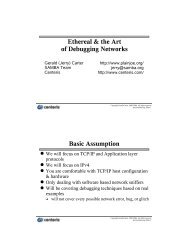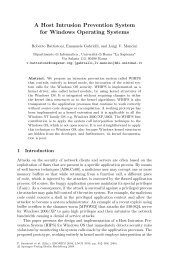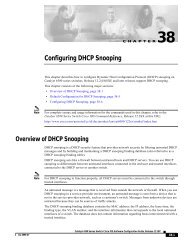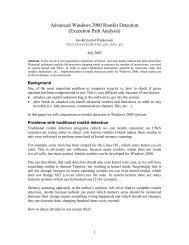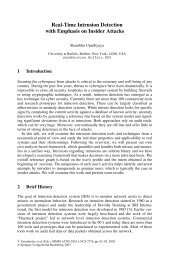ICSA Labs 10th Annual Virus Prevalence Survey 2004.pdf - Craig ...
ICSA Labs 10th Annual Virus Prevalence Survey 2004.pdf - Craig ...
ICSA Labs 10th Annual Virus Prevalence Survey 2004.pdf - Craig ...
- No tags were found...
Create successful ePaper yourself
Turn your PDF publications into a flip-book with our unique Google optimized e-Paper software.
<strong>ICSA</strong> <strong>Labs</strong> <strong>Virus</strong> <strong>Prevalence</strong> <strong>Survey</strong> 2004Executive Overview<strong>ICSA</strong> <strong>Labs</strong>’ annual <strong>Virus</strong> <strong>Prevalence</strong> <strong>Survey</strong> gathers data to measure the prevalence ofcomputer viruses and malware in medium to large companies. The <strong>ICSA</strong> Content SecurityLab and corporate sponsors, who support the survey each year, organized the Tenth <strong>Annual</strong><strong>Virus</strong> <strong>Prevalence</strong> <strong>Survey</strong> 2004. Qualified respondents who work for corporations andgovernment agencies with more than 500 PCs, two or more local area networks (LANs), andat least two remote connections completed the survey questionnaire. The annual reportdescribes the existing computer virus problems and attempts to interpret trends of viruspropagation and infection vectors, and explores possible risk mitigation methods.HOW COMMON ARE VIRUS ENCOUNTERS?This year’s sample of respondents reported more than 3.9 million virus incidents on morethan 900,000 desktops, servers, and perimeter gateways. This translates into 392 encountersper 1,000 machines, per month over the survey period from January 2004 through December2004, with a rate of 116 infections per month by the end of the survey period.WHAT ARE THE CHARACTERISTICS OF VIRUS DISASTERS?For this survey, a virus disaster equates to an incident in which 25 or more PCs or servers areinfected at the same time with the same virus or an incident causing significant damage ormonetary loss to the organization. When using the latter criterion, the respondents wereasked to qualify the disaster, i.e. number of machines, loss of data, loss of productivity,revenue loss, etc.WHAT ARE THE EFFECTS OF VIRUS DISASTERS?This year 112 of 300 respondents reported a virus disaster representing a 12 percent increaseover the 92 reports in 2003. Another point of significance was an increased recovery time.While recovery time had risen only slightly in 2003, this year’s rise was an increase of sevenperson days or almost 25 percent. 2004 also saw a significant jump in cost related to recovery,which rose to more than $130,000 marking, for the second year in a row of sharply increasingcosts. When one considers our respondents are technical persons responsible for virus protectionand remediation, it is not hard to understand the historical under-estimation of recovery costs.Our past research reveals technical respondents to our surveys have historicallyunderestimated recovery costs by at least a factor of seven, when one considers both direct andindirect costs. With that underestimation in mind, it is easy to see real recovery costs for avirus disaster being a great deal larger when all costs, both soft and hard are measured.HOW DID RESPONDENTS PERCEIVE THE EVOLUTION OF THE VIRUS PROBLEM?Again, respondents believe the problem is worsening. Only nine percent of this year’srespondents felt the problem was About the Same and none felt the situation was Better. Thisis an interesting point because last year was considered by respondents the worst yearreported! Ninety-one percent of respondents felt the virus problem was either Much orSomewhat Worse.Copyright 2005 <strong>ICSA</strong> <strong>Labs</strong>, a division of Cybertrust, Inc. All Rights Reserved.This information may not be incorporated into any other work and may be reproduced only with the express written permission of Cybertrust, Inc.Page 1



